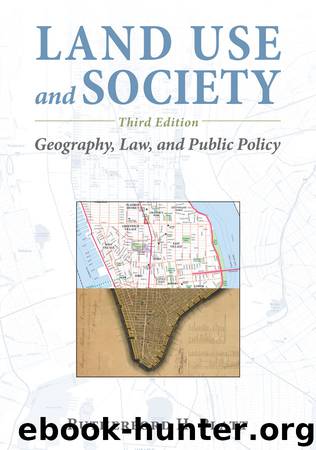Land Use and Society by Rutherford H. Platt

Author:Rutherford H. Platt
Language: eng
Format: epub
Publisher: Island Press
Published: 2014-03-18T04:00:00+00:00
Figure 6-4
A typical “metes and bounds” property plat showing parcels bounded by straight-line segments of exact length and compass heading starting at a designated “monument.”
First, the reference to a “red or black oak tree,” besides being botanically vague, leaves the boundary unmarked with the eventual disappearance of said tree. Second, the use of magnetic compass directions, which was universal at that time, left uncertainty as to the degree of compass error or divergence between magnetic north and true north, which varies from one place to another and changes over time.
Metes and bounds legal descriptions thus present many problems when old boundaries are resurveyed. Error arises from various sources, including inaccuracy of instruments, careless procedures, change of physical conditions, and illegibility of early field notes, yet property and political boundaries laid out in early times must be followed as faithfully as possible. The modern surveyor is armed with an array of new technology, including astronomical triangulation, satellite imagery, GPS, inertial guidance vehicles, and laser beams. Despite all this paraphernalia, when an ancient boundary must be redrawn, the modern surveyors must attempt to follow exactly in the footsteps of their pioneer predecessors.
Metes and bounds descriptions are cumbersome and susceptible to mistakes. A small error in direction (west instead of east, for instance) will send the boundary off into the blue, and no area is enclosed. A major source of error arose simply through the copying by hand or typing of a detailed boundary description.
Federal Land Survey
The Federal Land Survey originated in the Land Ordinance of 1785 as a land title registration system more adaptable than metes and bounds to the settlement of the nation’s vast territories beyond the Appalachian Mountains. As blocks of federal land were transferred to various recipients over the next century, the federal survey permanently impressed the legal footprint of central government on future landscapes from the Ohio River Valley to the Pacific Ocean. The 1785 Land Ordinance established the basic template for land transfers and settlement beginning with the “Old Northwest Territories” of Ohio, Indiana, Michigan, Illinois, and Wisconsin. The survey eventually extended from its designated “point of beginning” where the Ohio River crosses the western border of Pennsylvania as far west as the Aleutian Islands of Alaska and southward to Key West, Florida.10
The township is the basic geographic unit of the federal survey (Box 6-1). In its ideal form, a township is a rectangle of 6 miles on each side, divisible into thirty-six sections of 1 square mile each. Conveniently, 1 square mile equals 640 acres, which is easily divisible into “quarter-sections” of 160 acres each and smaller fractions for purposes of settlement and development. The legendary “forty acres and a mule” supposedly awarded to freed slaves after the Civil War referred to grants of a “quarter-quarter-section,” enough land to support a family in the Southeast.
Under a long series of federal laws, large blocks of land from the public domain were transferred as land grants to states, canal companies, railroads, mining and timber interests, state universities, and homesteaders.
Download
This site does not store any files on its server. We only index and link to content provided by other sites. Please contact the content providers to delete copyright contents if any and email us, we'll remove relevant links or contents immediately.
Killers of the Flower Moon by David Grann(3740)
Machine Learning at Scale with H2O by Gregory Keys | David Whiting(3563)
Oathbringer (The Stormlight Archive, Book 3) by Brandon Sanderson(2577)
Will by Will Smith(2567)
Once Upon a Broken Heart by Stephanie Garber(2508)
Guns, Germs and Steel by Diamond Jared(2189)
Borders by unknow(2113)
The Room Where It Happened by John Bolton;(2029)
It Starts With Us (It Ends with Us #2) by Colleen Hoover(1995)
Friends, Lovers, and the Big Terrible Thing by Matthew Perry(1978)
The Color of Law by Richard Rothstein(1808)
HBR's 10 Must Reads 2022 by Harvard Business Review(1692)
The Strength In Our Scars by Bianca Sparacino(1687)
A Short History of War by Jeremy Black(1663)
Water Rights and the Environment in the United States by John Burch(1603)
Examples & Explanations: Administrative Law by William F. Funk & Richard H. Seamon(1546)
515945210 by Unknown(1517)
Pharmacy Practice and The Law by Richard Abood(1489)
That Every Man Be Armed by Stephen P. Halbrook(1473)
